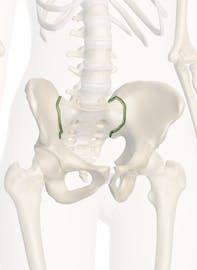The Sacroiliac Joint
Explore the anatomy and structure of the sacroiliac joint in the pelvis with Innerbody's 3D model.

The sacroiliac joint is a synovial planar joint formed in the pelvis between the ilium and the sacrum. The sacroiliac joint allows for the slight shifting of these bones relative to each other to increase the flexibility of the pelvis, especially during childbirth.
Like all other synovial joints, a thin layer of smooth articular cartilage covers the joint-forming processes of the ilium and the sacrum at the sacroiliac joint. The articular surfaces of both bones are rough and bumpy, providing an interlocking surface to prevent extraneous movement at the joint. A small, fluid-filled space between the bones allows for some movement. Surrounding this space is a joint capsule of dense fibrous connective tissue, which provides strength and stability to the pelvis. Oily synovial fluid produced by the synovial membrane inside the joint capsule fills the hollow space between the bones and lubricates the joint to reduce friction and wear.
Two main ligaments extend from the joint capsule to reinforce the joint and anchor the bones in their positions.
The anterior sacroiliac ligament is a broad, thin ligament that spreads its collagen fibers across the anterior surfaces of the ilium and sacrum to firmly bind them together on the inside of the pelvis.
On the opposite side of the joint, the posterior sacroiliac ligament binds the posterior surface of the sacrum to the posterior surface of the ilium and the superior iliac spine. The posterior sacroiliac ligament is considerably thicker and stronger than the anterior sacroiliac ligament and accounts for most of the reinforcement of the joint.
Functionally, the sacroiliac joint is a planar diarthrosis, meaning that it allows the bones to glide past one another in any direction along their plane of intersection. The irregular shape of the bones, however, severely limits the range of movement at the joint but helps to strengthen the joint and prevent dislocation. As the entire upper body's weight is transferred from the spine to the legs through the sacroiliac joint, it is extremely important that the joint is maintained in its proper position. Through its articular cartilage, the sacroiliac joint also acts as a shock absorber to limit the force transfer between the spine and pelvis. Movements at the sacroiliac joint help to increase the range of motion of the legs relative to the trunk, much like the movement of the shoulder blades works with the shoulder joint. The sacroiliac joint also shifts the body's weight at the pelvis during locomotion as the hips swing slightly while taking a step.
During pregnancy, the ovaries and placenta produce the hormone relaxin to increase the flexibility of the pelvis in preparation for childbirth. One of the effects of relaxin is the increased flexibility of the ligaments that hold the sacroiliac joint together, resulting in a looser joint and increased range of motion. The loosening of the sacroiliac joint and pubic symphysis allows the pelvis to accommodate the head of the fetus passing through the birth canal.


